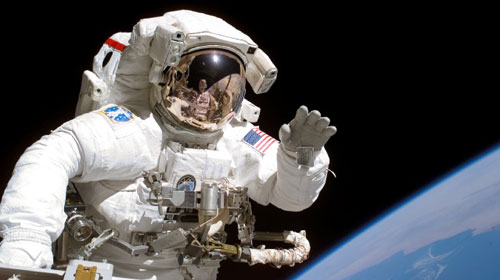Former NASA Astronaut Joe Tanner to Teach Aerospace Engineering at CUFollowing a 24-year career with NASA that included four space shuttle flights and seven space walks, former astronaut Joe Tanner has set his sights on a new challenge: helping University of Colorado at Boulder students reach their academic and lifetime goals.
Tanner joined CU-Boulder's aerospace engineering sciences department last month as a senior instructor -- one of only a handful of astronauts to take on a teaching position after retiring from government service.
"I have a passion for students -- that's why I came here," said Tanner, a former Colorado resident who lived in Frisco before going to work at NASA's Johnson Space Center in 1984. "If I can help students reach their academic and life goals in some way, I really feel I've helped humanity."
This fall, Tanner will bring his considerable spaceflight and project management experience to assist with the senior projects course in aerospace engineering and to work with graduate student projects in preparation for overseeing the master's projects course next semester. He also hopes to be involved with the BioServe Space Technologies research center in the future.
Aerospace engineering sciences Chair Jeffrey Forbes is especially enthusiastic about Tanner's arrival: "Joe's leadership in our student projects arena launches the educational component of our new AeroSpace Systems Science and Engineering initiative, which will be developing over the next few years." The cross-disciplinary initiative seeks to better integrate the engineering of aerospace vehicles and sensor systems with earth and space science applications.
Tanner's direct involvement with NASA engineering and science missions will continue next month as he heads back to the Johnson Space Center for the mid-October launch of NASA's fifth and final Hubble Space Telescope servicing mission. The mission involves five spacewalks and a $70 million instrument known as the Cosmic Origins Spectrograph, designed by CU-Boulder.
Two of Tanner's seven spacewalks were performed in 1997 to improve the science capability of the Hubble Space Telescope, and he has worked closely with the current mission crew over the last year as an instructor in the Astronaut Office. Tanner will monitor flight activities from Mission Control to advise the extravehicular activity, or EVA, team as necessary throughout the five spacewalks. "The crew tells me they will feel a lot better with me still being part of the team," he said.
Tanner earned his bachelor's degree in mechanical engineering at the University of Illinois in 1973. He joined the Navy after graduation where he earned his pilot wings in 1975, served as an A-7E light-attack pilot aboard the USS Coral Sea, and completed active service as an advanced jet instructor pilot in Pensacola, Fla.
Tanner started working for NASA in 1984 as an aerospace engineer and research pilot, with duties that included teaching Space Shuttle landing techniques to astronaut pilots.
He was selected as an astronaut candidate in 1992, and has logged 1,069 hours in space, including over 46 EVA hours in seven space walks. He served as a mission specialist on flights in 1994, 1997, 2000 and 2006. The latter two, in which Tanner made a total of five spacewalks, were assembly missions to the International Space Station.
Tanner looks forward to bringing his years of operational experience with the Navy and NASA to help the university launch the AeroSpace Systems Science and Engineering initiative.












